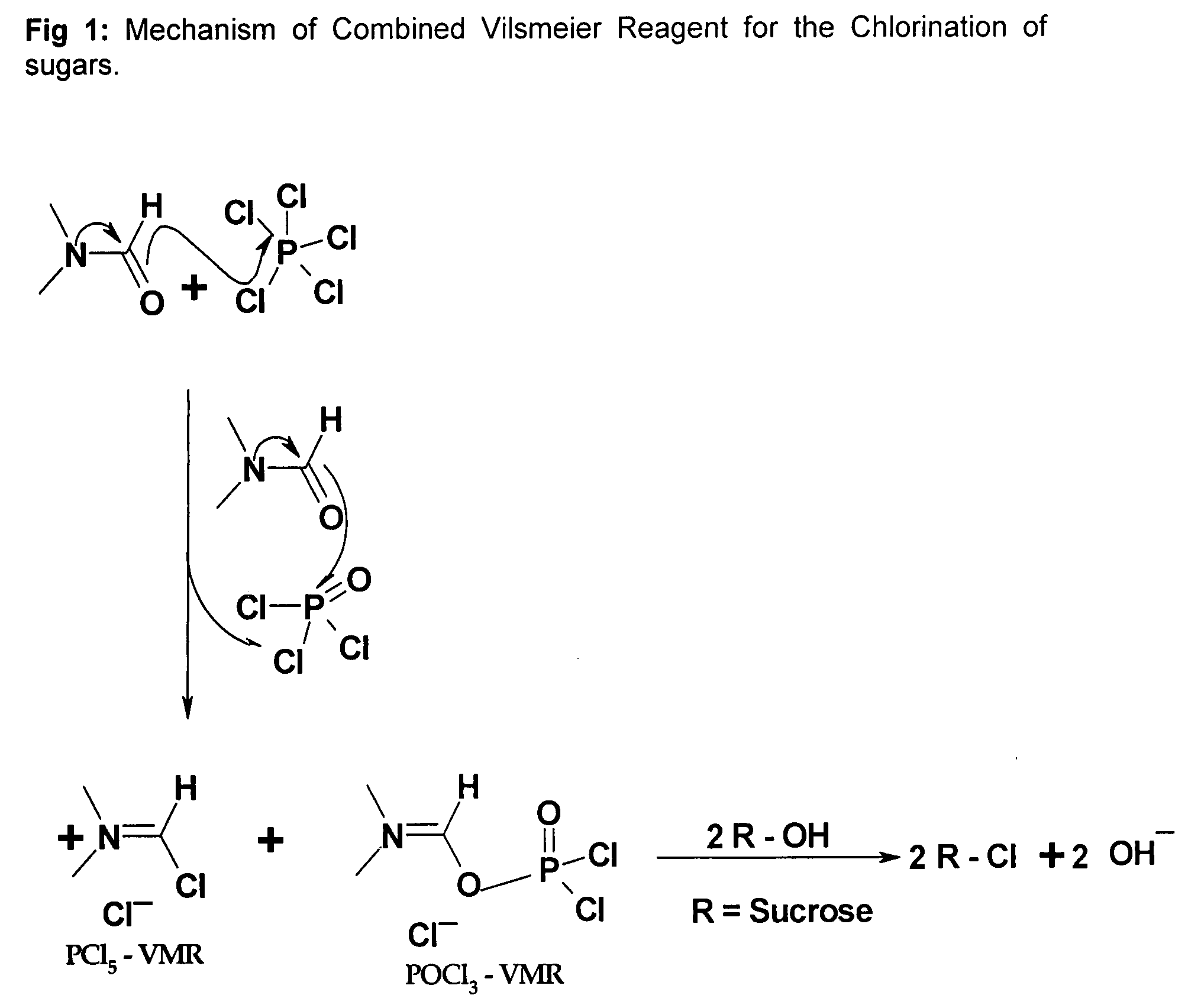Generation of Phosphorus Oxychloride as by-Product from Phosphorus Pentachloride and DMF and its Use for Chlorination Reaction by Converting Into Vilsmeier-Haack Reagent
a technology of phosphorus pentachloride and phosphorus oxychloride, which is applied in the preparation of isocyanic acid derivatives, phosphorus halides/oxyhalides, esterified saccharide compounds, etc., can solve the problem of using pclsub>5
- Summary
- Abstract
- Description
- Claims
- Application Information
AI Technical Summary
Benefits of technology
Problems solved by technology
Method used
Image
Examples
example 1
Formation of Second Crop of Vilsmeier-Haack Reagent from Byproduct POCl3 Formed from PCl5 after Formation of First Crop of the Reagent
[0029]PCl5, 835 g, was added to a round bottom flask containing 0.835 L of DMF at 20° C. The Vilsmeier-Haack reaction was accomplished indicated by the formation of white crystals of Vilsmeier-Haack reagent. After about 15 min, the liberated POCl3 also started forming the Vilsmeier-Haack reagent and formed an orange red solution along with the solid. The mixture was then stirred thoroughly for 1.0 hr at room temperature. An excess of DMF, 500 ml, was added to the reaction. The mixture was cooled to 0° C. and the substrate containing 263 g of sucrose equivalent (sucrose-6-acetate) was added drop wise. The temperature was maintained below 0° C. during addition.
[0030]After the completion of addition of the substrate, the temperature was allowed to come to ambient and stirred for 1.0 hr. The temperature was then raised to 65° C., maintained for 1.5 hrs an...
example 2
Chlorination by Vilsmeier-Haack Reagent Formed from PCl5 Only
[0031]This experiment was carried out to show the efficiency of chlorination using only Vilsmeier-Haack reagent generated from PCl5. 835 g of PCl5 was added to a round bottom flask containing 0.835 L of DMF at 20° C. The Vilsmeier-Haack reaction was accomplished and was observed by the formation of white crystals of Vilsmeier-Haack reagent. The reaction was accompanied by the formation of POCl3 which started to react with the available excess of DMF to form the second Vilsmeier-Haack reagent. But this Vilsmeier-Haack reagent that forms is in liquid form and doesn't become a solid Vilsmeier-Haack reagent as in the case of PCl5. So, in order to ascertain and demonstrate efficacy of Vilsmeier-Haack reagent formed from PCl5, the PCl5 Vilsmeier-Haack reagent formed was filtered off and the POCl3 and the excess DMF was separated out completely. The Vilsmeier-Haack reagent in solid form was washed with DMF and was taken up for th...
example 3
Chlorination by Vilsmeier-Haack Reagent Formed from POCl3 Only
[0034]This experiment was carried out to show the efficiency of chlorination using only Vilsmeier-Haack reagent generated from POCl3. 614.2 g of POCl3 was added drop wise to a reaction flask containing 1250 ml of DMF. The temperature was maintained between 0 to 5° C. The formation of the Vilsmeier-Haack reagent was confirmed by the orange colour formation in the flask. The mixture was stirred for 1 hour for completion of the reagent formation and then the contents were cooled to 0 to −5° C. The substrate containing 132 g of sucrose equivalent (sucrose-6-acetate) was added drop wise. The temperature was maintained below 0° C. during addition.
[0035]After the completion of addition of the substrate, the temperature was allowed to come to ambient and stirred for 1.0 hr. The temperature was then raised to 65° C., maintained for 1.5 hrs and further heated to 80° C. and maintained for 1.0 hr. Further the temperature was raised u...
PUM
| Property | Measurement | Unit |
|---|---|---|
| temperature | aaaaa | aaaaa |
| temperature | aaaaa | aaaaa |
| temperature | aaaaa | aaaaa |
Abstract
Description
Claims
Application Information
 Login to View More
Login to View More - R&D
- Intellectual Property
- Life Sciences
- Materials
- Tech Scout
- Unparalleled Data Quality
- Higher Quality Content
- 60% Fewer Hallucinations
Browse by: Latest US Patents, China's latest patents, Technical Efficacy Thesaurus, Application Domain, Technology Topic, Popular Technical Reports.
© 2025 PatSnap. All rights reserved.Legal|Privacy policy|Modern Slavery Act Transparency Statement|Sitemap|About US| Contact US: help@patsnap.com


